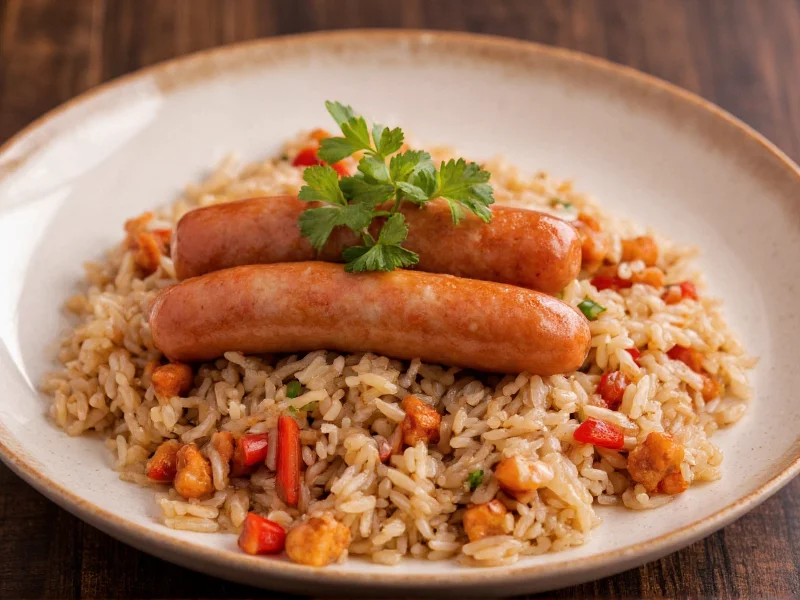Understanding Rice Sausage: A Culinary Tradition Across Asia
Rice sausage represents a fascinating culinary adaptation that transforms simple ingredients into a complex, satisfying dish. This specialty food bridges the gap between staple grains and protein sources, creating a complete meal in a single preparation. While many Western diners might find the concept unusual, rice-based sausages have been enjoyed throughout Asia for centuries, each region developing its own distinctive version.
Cultural Origins and Historical Significance
The history of rice sausage traces back to ancient preservation techniques in humid Asian climates where fresh meat spoiled quickly. By combining cooked glutinous rice with seasoned pork and encasing the mixture, communities created a portable, long-lasting food source. Chinese immigrants later introduced variations of this concept to Southeast Asia, where local ingredients transformed the original recipe.
In Southern China, particularly Guangdong province, rice sausage became a staple of dim sum culture. The Cantonese version typically includes Chinese sausage (lap cheong), dried scallops, and shiitake mushrooms wrapped in lotus leaves before steaming. This preparation method, known as lo mai gai, translates to "sticky rice with chicken" though pork variations are equally common.
Key Ingredients That Define Authentic Rice Sausage
Creating authentic rice sausage requires careful selection of ingredients that work in harmony:
| Ingredient Category | Essential Components | Regional Variations |
|---|---|---|
| Rice Base | Glutinous rice (soaked 4+ hours), water ratio 1:1.2 | Thai versions sometimes add coconut milk |
| Protein Elements | Fatty pork (30% fat), Chinese sausage, dried shrimp | Vietnamese versions include pâté |
| Aromatic Seasonings | Five-spice powder, ginger, soy sauce, sesame oil | Malaysian versions add lemongrass |
| Texture Enhancers | Dried mushrooms, water chestnuts, bamboo shoots | Filipino versions include hard-boiled eggs |
Traditional Preparation Techniques
The preparation of rice sausage requires precision at every stage. First, glutinous rice must soak for at least four hours to ensure proper texture. Meanwhile, the pork gets marinated with soy sauce, rice wine, and five-spice powder for a minimum of two hours. The magic happens during assembly: the seasoned rice and meat mixture must maintain a precise 2:1 ratio to prevent either mushiness or dryness.
Traditional methods involve wrapping the mixture in lotus leaves before steaming, which imparts a subtle floral aroma. Modern adaptations often use sausage casings or even banana leaves for easier preparation. The steaming process requires careful timing—typically 45-60 minutes—to cook the rice thoroughly without making it gummy. Many experienced cooks recommend a final resting period of 15 minutes after steaming to allow the flavors to meld and the texture to set properly.
Regional Variations Across Asia
Each Asian region has developed distinctive rice sausage interpretations that reflect local tastes and available ingredients:
Chinese Rice Sausage (Lo Mai Gai)
The classic Cantonese version features glutinous rice with Chinese sausage, dried mushrooms, and sometimes chicken or pork belly. Wrapped in lotus leaves and steamed, this dim sum staple balances savory and slightly sweet flavors. The rice should remain distinct yet cohesive, with the lotus leaf adding an earthy undertone.
Thai Khao Kha Moo Sai Krong
In Thailand, rice sausage often incorporates coconut milk into the rice mixture, creating a richer texture. Street food vendors frequently serve it with a tangy cucumber relish and sweet chili sauce. The Thai version typically uses less meat than Chinese varieties, focusing more on the seasoned rice component.
Vietnamese Xoi Cha Long
Vietnamese adaptations sometimes include pâté and Vietnamese sausage (chả lụa) layered within the rice mixture. Served with pickled vegetables and fish sauce, this version offers a more complex flavor profile with sweet, sour, and umami elements working in harmony.
Serving Suggestions and Pairing Options
Rice sausage serves as both a standalone meal and a component in larger dishes. For traditional presentation, slice the sausage into 1-inch rounds and arrange on a platter with fresh cucumber slices and pickled vegetables. Many Asian households serve rice sausage with a side of Chinese broccoli (gai lan) blanched with garlic.
The dish pairs exceptionally well with light, floral teas that cut through the richness—jasmine or oolong tea provide ideal complements. For modern interpretations, chefs sometimes pan-sear sliced rice sausage to create a crispy exterior while maintaining a soft interior, serving it with a drizzle of chili oil and scallions.
Storage and Shelf Life Guidelines
Proper storage ensures rice sausage maintains both safety and quality. Freshly prepared rice sausage keeps for 3-4 days in the refrigerator when stored in an airtight container. For longer preservation, wrap individual portions tightly in plastic wrap before placing in freezer bags—properly frozen, it maintains quality for up to three months.
When reheating, steaming remains the preferred method to restore the original texture. Microwave reheating often makes the rice too soft, while pan-frying can create an uneven texture. If frozen, allow the sausage to thaw completely in the refrigerator before reheating to ensure even warming without drying out the exterior.
Troubleshooting Common Rice Sausage Issues
Even experienced cooks encounter challenges with rice sausage preparation. Mushy texture usually indicates insufficient soaking time for the rice or excessive water during cooking. For optimal results, maintain the precise 1:1.2 rice-to-water ratio and ensure thorough soaking.
Dry, crumbly sausage typically results from too little fat content in the meat mixture or overcooking. Using pork with at least 30% fat content and monitoring steaming time carefully prevents this issue. If the sausage won't hold its shape, the rice-to-meat ratio likely needs adjustment—increasing the meat content slightly improves structural integrity without compromising the essential rice-forward character.











 浙公网安备
33010002000092号
浙公网安备
33010002000092号 浙B2-20120091-4
浙B2-20120091-4